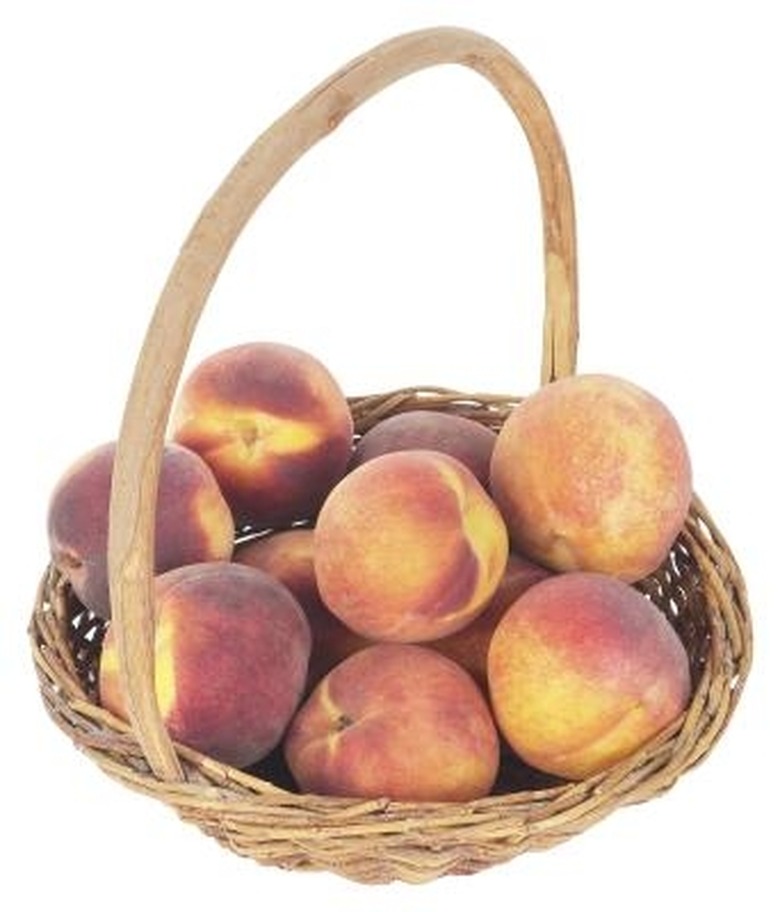What Are The Different Types Of Peaches?
Originally native to China, peaches are a sweet, fuzzy-skinned fruit commonly used in cobblers, pies and preserves. In the United States, peaches are the official state fruit of Georgia, where roughly 130 million lbs. of peaches are produced annually, according the the University of Georgia College of Agricultural and Environmental Sciences. There are countless varieties of peaches in the world that fall within several peach types.
Yellow-Flesh Peaches
Yellow-flesh peaches posses a mixture of both sweet and acidic flavor. Yellow-flesh peaches usually have yellow or orange flesh with a dark red center surrounding the pit. When eating a yellow-flesh peach, you may notice a slight "tang" on your taste buds due to the acidity of the fruit, though the flavor is described to be smooth. Yellow-flesh peaches are grown throughout North America and Europe where countless varieties of the fruit have been cultivated. Yellow-flesh peaches are in season May through September.
- Originally native to China, peaches are a sweet, fuzzy-skinned fruit commonly used in cobblers, pies and preserves.
- Yellow-flesh peaches are grown throughout North America and Europe where countless varieties of the fruit have been cultivated.
White-Flesh Peaches
White-flesh peaches are lighter in color than yellow-flesh peaches and are also less acidic. The flesh of the peach is usually white or cream in color while the center surrounding the pit is pink or red. White-flesh peaches are sweet in flavor but lack the tart tanginess yellow-flesh varieties possess. These peaches are usually grown in Asia and are in season May through August.
Clingstone Peaches
Peaches that have flesh that sticks to the pit of the fruit are known as clingstone peaches. Clingstone varieties may be yellow- or white-flesh and tend to be extremely juicy and sweet. When eating a clingstone peach, the flesh needs to be cut away from the pit with a knife. According to Growing Taste, most clingstone peaches are used for processing rather than for desserts because of the hassle associated with separating the flesh from the pit.
- White-flesh peaches are lighter in color than yellow-flesh peaches and are also less acidic.
- White-flesh peaches are sweet in flavor but lack the tart tanginess yellow-flesh varieties possess.
Freestone Peaches
Peaches that have flesh that easily separates from the pit are known as freestone peaches. Freestone peaches can also be either yellow- or white-flesh depending on the variety. Freestone peaches are the kind most commonly found in supermarkets and used in desserts. However, freestone peaches tend to be less juicy and sweet than clingstone types.
Melting Flesh
Melting flesh peaches have flesh that tends to fall apart and soften over time. These peaches will also tear and become raggedy when cut with a knife. Both freestone and clingstone peaches can have melting flesh. Melting flesh peaches are usually used in pies, cobblers and other desserts and are also eaten raw or sliced in other foods such as salads.
- Peaches that have flesh that easily separates from the pit are known as freestone peaches.
- Both freestone and clingstone peaches can have melting flesh.
Non-Melting Flesh
Non-melting flesh peaches have flesh that will stay firm over time, making varieties of this type ideal for canning and processed foods. Non-melting flesh can be used in desserts though this is not very common. Non-melting peaches are always clingstone.
Peento Peaches
Peento peaches are a Chinese type of peach that are flat or doughnut shaped rather than spherical like other types. Peento peaches come in a variety of colors and flesh types. In the United States, peento peaches are grown in California and Washington.
